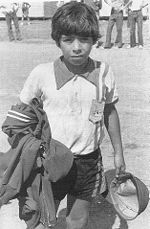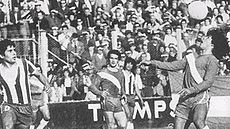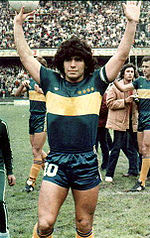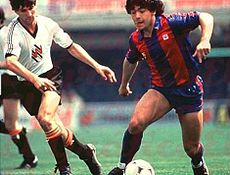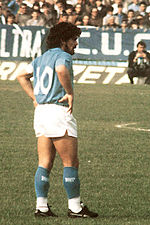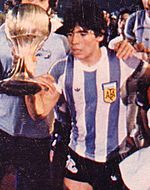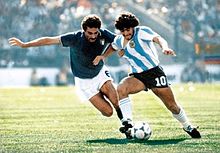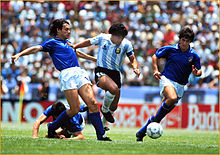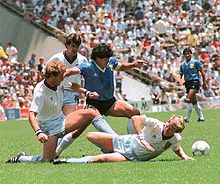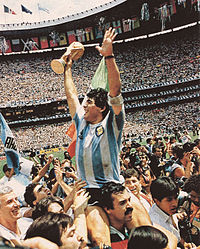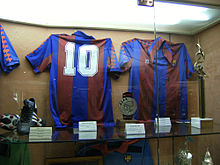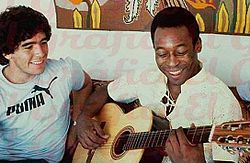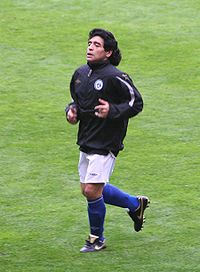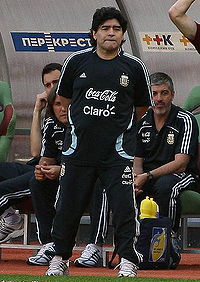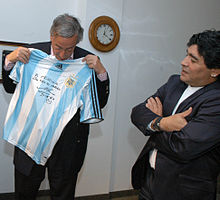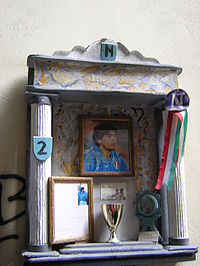
Diego Maradona
Did you know...
This wikipedia selection has been chosen by volunteers helping SOS Children from Wikipedia for this Wikipedia Selection for schools. SOS Children is the world's largest charity giving orphaned and abandoned children the chance of family life.
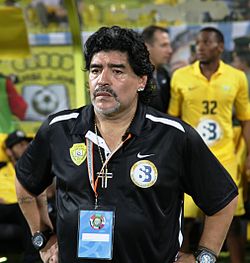 Maradona with Al Wasl in 2012 |
||||||||||||
| Personal information | ||||||||||||
|---|---|---|---|---|---|---|---|---|---|---|---|---|
| Full name | Diego Armando Maradona | |||||||||||
| Date of birth | 30 October 1960 | |||||||||||
| Place of birth | Lanús, Buenos Aires, Argentina | |||||||||||
| Height | 1.65 m (5 ft 5 in) | |||||||||||
| Playing position | Attacking Midfielder Second striker |
|||||||||||
| Youth career | ||||||||||||
| 1968–1969 | Estrella Roja | |||||||||||
| 1970–1974 | Los Cebollitas | |||||||||||
| 1975–1976 | Argentinos Juniors | |||||||||||
| Senior career* | ||||||||||||
| Years | Team | Apps† | (Gls)† | |||||||||
| 1976–1981 | Argentinos Juniors | 167 | (115) | |||||||||
| 1981–1982 | Boca Juniors | 40 | (28) | |||||||||
| 1982–1984 | Barcelona | 36 | (22) | |||||||||
| 1984–1991 | Napoli | 188 | (81) | |||||||||
| 1992–1993 | Sevilla | 26 | (5) | |||||||||
| 1993–1994 | Newell's Old Boys | 5 | (0) | |||||||||
| 1995–1997 | Boca Juniors | 30 | (7) | |||||||||
| Total | 492 | (258) | ||||||||||
| National team | ||||||||||||
| 1977–1994 | Argentina | 91 | (34) | |||||||||
| Teams managed | ||||||||||||
| 1994 | Mandiyú de Corrientes | |||||||||||
| 1995 | Montenegro | |||||||||||
| 2008–2011 | Argentina | |||||||||||
| 2011–2012 | Al Wasl | |||||||||||
|
Honours
|
||||||||||||
| * Senior club appearances and goals counted for the domestic league only. † Appearances (Goals). |
||||||||||||
Diego Armando Maradona (Spanish pronunciation: [ˈdjeɣo maɾaˈðona], born 30 October 1960) is an Argentine football coach as well as a manager and former player. Many experts, football critics, former players, current players and football fans consider Maradona to be the greatest football player of all time. He was joint FIFA Player of the 20th Century with Pelé.
He is the only footballer to set world-record contract fees twice, firstly when transferring to Barcelona for a then world record £5m, and secondly, when transferred to Napoli for another record fee £6.9m. During his professional club career Maradona played for Argentinos Juniors, Boca Juniors, Barcelona, Napoli, Sevilla and Newell's Old Boys. At club level, he is most famous for his career in Napoli where he won numerous accolades. In his international career, playing for Argentina, he earned 91 caps and scored 34 goals.
He played in four FIFA World Cup tournaments, including the 1986 tournament, where he captained Argentina and led them to their victory over West Germany in the final, winning the Golden Ball award as the tournament's best player. In that same tournament's quarterfinal round, he scored both goals in a 2–1 victory over England that entered football history, though for two different reasons. The first goal was via an unpenalized handball known as the " Hand of God", while the second goal followed a 60 m (66 yd) dribble past five England players, voted " The Goal of the Century" by FIFA.com voters in 2002.
Maradona is considered one of the sport's most controversial and newsworthy figures. He was suspended from football for 15 months in 1991 after failing a drug test, for cocaine, in Italy, and he was sent home from the 1994 World Cup in the USA after testing positive for ephedrine. In 2005, he lost a considerable amount of extra weight and overcame his cocaine addiction. His outspoken manners have sometimes put him at odds with journalists and sport executives. Although he had little managerial experience, he became head coach of the Argentina national team in November 2008, and held the job for eighteen months, until his contract expired after the 2010 World Cup.
Early years
Diego Maradona was born on 30 October 1960, at the Policlínico (Polyclinic) Evita Hospital in Lanús, Buenos Aires Province, but raised in Villa Fiorito, a shantytown on the southern outskirts of Buenos Aires, to a poor family that had moved from Corrientes Province. He was the first son after three daughters. He has two younger brothers, Hugo (el Turco) and Raúl (Lalo), both of whom were also professional football players. Maradona has Spanish, and indigenous ancestry.
He was the fifth child and first son of 'Chitoro' Diego Maradona and ‘Doña Tota’ Dalma Salvadora Franco (1930–2011). Both his parents were illegitimate children; his father took the family name of his mother because his father did not recognise him as his own while his mother was only recognised by her father, Maradona's grandfather Atanancio Ramón Edisto Franco when she was eighteen years old. They were both born and brought up in the town of Esquina in the north-east province of Corrientes Province, living only two hundred yards from each other on the banks of the Corriente River. In 1950, they left Esquina and settled in Buenos Aires. Maradona is a mestizo, a term traditionally used in Spain and Latin America for people of mixed Native American and European descent.
There is a dispute as to the source of the name Maradona. It had long been believed that it was of Italian origin, however Spanish researchers assert that the name originated from the region of Galicia.
At age 10, Maradona was spotted by a talent scout while he was playing in his neighbourhood club Estrella Roja. He became a staple of Los Cebollitas (The Little Onions), the junior team of Buenos Aires's Argentinos Juniors. As a 12-year-old ball boy, he amused spectators by showing his wizardry with the ball during the halftime intermissions of first division games.
Club career
Argentinos Juniors and Boca Juniors
On 20 October 1976, Maradona made his professional debut with Argentinos Juniors, ten days before his sixteenth birthday. He played there between 1976 and 1981, scoring 115 goals in 167 appearances before his £1m transfer to Boca Juniors. Having joined the Boca squad midway through the 1981 season, Maradona played through 1982 earning his first league championship medal. Whilst playing for Argentinos Juniors, English club Sheffield United negotiated a fee of £600,000 for the 17-year old but then realised they couldn't afford it.
Barcelona
After the 1982 World Cup, in June, Maradona was transferred to FC Barcelona in Spain for a then world record fee of £5m ($7.6m). In 1983, under coach César Luis Menotti, Barcelona and Maradona won the Copa del Rey (Spain's annual national cup competition), beating Real Madrid, and the Spanish Super Cup, beating Athletic Bilbao. However, Maradona had a difficult tenure in Barcelona. First a bout with hepatitis, then a broken ankle caused by an ill-timed tackle by Athletic's Andoni Goikoetxea threatened with jeopardizing Maradona's career, but after treatment and therapy it was possible for him to soon be back on the pitch.
During his two injury-hit seasons at Barcelona, Maradona scored 38 goals in 58 games. At Barcelona, Maradona got into frequent disputes with the team's directors, especially club president Josep Lluís Núñez, culminating with a demand to be transferred out of Camp Nou in 1984. He was transferred to Napoli in Italy's Serie A for another world record fee, £6.9m ($10.48m).
Napoli
At Napoli, Maradona reached the peak of his professional career. He quickly became an adored star among the club's fans, and in his time there he elevated the team to the most successful era in its history. Led by Maradona, Napoli won their only Serie A Italian Championships in 1986/87 and 1989/1990, placing second in the league twice, in 1987/88 and 1988/89. Other honours during the Maradona era at Napoli included the Coppa Italia in 1987, (second place in the Coppa Italia in 1989), the UEFA Cup in 1989 and the Italian Supercup in 1990. Maradona was the top scorer in Serie A in 1987/88.
During his time in Italy, Maradona's personal problems increased. His cocaine use continued, and he received US $70,000 in fines from his club for missing games and practices, ostensibly because of 'stress'. He faced a scandal there regarding an illegitimate son; and he was also the object of some suspicion over an alleged friendship with the Camorra.
Later on, in honour of Maradona and his achievements during his career at Napoli, the No. 10 jersey of Napoli was officially retired.
Sevilla, Newell's Old Boys and Boca Juniors
After serving a 15-month ban for failing a drug test for cocaine, Maradona left Napoli in disgrace in 1992. Despite interest from Real Madrid of Spain and Olympique Marseille of France, he signed for Sevilla of Spain, where he stayed for one year. In 1993 he played for Newell's Old Boys and in 1995 he returned to Boca Juniors for two years. Maradona also appeared for Tottenham Hotspur in a friendly match against Internazionale, shortly before the 1986 World Cup. The match was Osvaldo Ardiles' testimonial, who insisted his friend Maradona played, which Tottenham won 2–1. He played alongside Glenn Hoddle, who gave up his number ten shirt for the Argentine.
International career
Along with his time at Napoli, international football is where Maradona found his fame. Playing for the Albicelestes of the Argentina national football team, he participated in four consecutive FIFA World Cup tournaments, leading Argentina to victory in 1986 and to second place in 1990.
He made his full international debut at age 16, against Hungary on 27 February 1977. At age 18, he played the World Youth Championship for Argentina, and was the star of the tournament, shining in their 3–1 final win over the Soviet Union. On 2 June 1979, Maradona scored his first senior international goal in a 3–1 win against Scotland at Hampden Park. He is the only player to win the Golden Ball at both the FIFA U-20 World Cup and FIFA World Cup, in 1979 and 1986.
1982 World Cup
Maradona played his first World Cup tournament in 1982. Argentina played Belgium in the opening game of the 1982 Cup in Barcelona. The Catalan crowd was eager to see their new world-record signing Diego Maradona in action, but he did not perform to expectations. Argentina, the defending champions, lost to Belgium 1–0. Although the team convincingly beat Hungary and El Salvador to progress to the second round, they were defeated in the second round by Brazil and by eventual winners Italy. The Italian match is renowned for Maradona being aggressively man-marked by Claudio Gentile, as Italy beat Argentina in Maradona's new home city of Barcelona. Maradona played in all five matches without being substituted, scoring twice against Hungary, but was sent off with 5 minutes remaining in the game against Brazil for serious foul play.
1986 World Cup
Maradona captained the Argentine national team to victory in the 1986 FIFA World Cup, winning the final in Mexico against West Germany. Throughout the 1986 World Cup Maradona asserted his dominance and was the most dynamic player of the tournament. He played every minute of every Argentina game, scored 5 goals and made 5 assists, three of those in the opening match against South Korea. His first goal of the tournament came against Italy in the second group game. After scoring two goals in the 2–1 quarter-final win against England his legend was cemented.
This match was played with the background of the Falklands War between Argentina and the United Kingdom and emotions were still lingering in the air throughout the entire match. Replays showed that the first goal was scored by striking the ball with his hand. Maradona was coyly evasive, describing it as "a little with the head of Maradona and a little with the hand of God." It became known as the "Hand of God". Ultimately, on 22 August 2005 Maradona acknowledged on his television show that he had hit the ball with his hand purposely, and no contact with his head was made, and that he immediately knew the goal was illegitimate. This became known as an international fiasco in World Cup history. The goal stood, much to the wrath of the English players.
Maradona, turns like a little eel, he comes away from trouble, little squat man... comes inside Butcher and leaves him for dead, outside Fenwick and leaves him for dead, and puts the ball away... and that is why Maradona is the greatest player in the world.
Maradona's second goal, just four minutes after the hotly disputed hand-goal, was later voted by FIFA as the greatest goal in the history of the World Cup. He received the ball in his own half, swivelled around, and with 11 touches ran more than half the length of the field, dribbling past five English outfield players ( Peter Beardsley, Steve Hodge, Peter Reid, Terry Butcher, and Terry Fenwick) and goalkeeper Peter Shilton. This goal was voted " Goal of the Century" in a 2002 online poll conducted by FIFA.
Maradona followed this with two more goals in the semi-final against Belgium, including another virtuoso dribbling display for the second goal. In the final, the opposing West German side attempted to contain him by double-marking, but he nevertheless found the space to give the final pass to Jorge Burruchaga for the winning goal. Argentina beat West Germany 3–2 in front of 115,000 spectators at the Azteca Stadium.
During the course of the tournament, Maradona attempted or created more than half of Argentina's shots, embarked on 90 dribbles some three times more than any other player and was fouled 53 times winning his team twice as many free kicks as any player. Maradona scored or assisted 10 of Argentina's 14 goals including the assist for the winning goal in the final, ensuring that he would be remembered as one of the greatest names in football history.
By the end of the tournament, Maradona went on to winning the Golden Ball as the best player of the tournament by unanimous vote and was widely regarded to have won the World Cup virtually single-handedly. In a tribute to him, the Azteca Stadium authorities also built a statue of him scoring the "goal of the century" and placed it at the entrance of the stadium.
1990 World Cup
Maradona captained Argentina again in the 1990 FIFA World Cup to yet another World Cup Final. An ankle injury affected his overall performance, and he was much less dominant than four years earlier. Argentina were almost eliminated in the first round, only qualifying in third position from their group. In the round of 16 match against Brazil, Claudio Caniggia scored the only goal after being set up by Maradona.
In the quarter final, Argentina faced Yugoslavia, the match ending 0–0 after 120 minutes, and Argentina advancing on penalty kicks, despite Maradona missing one of the penalties in the shootout with a weak shot to the goalkeeper's right. The semifinal against the host nation Italy was also resolved on penalties after a 1–1 draw; this time, Maradona was successful with his effort, daringly rolling the ball into the net with an almost exact replica of his missed shot in the previous round. In the final, Argentina lost 1–0 to West Germany, the only goal being a penalty by Andreas Brehme in the 85th minute after a controversial foul on Rudi Völler.
1994 World Cup
At the 1994 FIFA World Cup Maradona played in only two games, scoring one goal against Greece, before being sent home after failing a drug test for ephedrine doping. In his autobiography, Maradona argued that the test result was due to his personal trainer giving him the power drink Rip Fuel. His claim was that the U.S. version, unlike the Argentine one, contained the chemical and that, having run out of his Argentine dosage, his trainer unwittingly bought the U.S. formula. FIFA expelled him from USA '94 and Argentina were subsequently eliminated in the second round. Maradona has also separately claimed that he had an agreement with FIFA, on which the organization reneged, to allow him to use the drug for weight loss before the competition in order to be able to play.
His failed drugs test at the 1994 World Cup signaled the end of his international career, which had lasted 17 years and yielded 34 goals from 91 games.
Playing style
Maradona had a compact physique and could withstand physical pressure well. His strong legs and low centre of gravity gave him an advantage in short sprints. His physical strengths were illustrated by his two goals against Belgium in the 1986 World Cup. Maradona was a strategist and a team player, as well as highly technical with the ball. He could manage himself effectively in limited spaces, and would attract defenders only to quickly dash out of the melee (as in the second 1986 goal against England), or give an assist to a free teammate. Being short, but strong, he could hold the ball long enough with a defender on his back to wait for a teammate making a run or to find a gap for a quick shot.
One of Maradona's trademark moves was dribbling full-speed on the right wing, and on reaching the opponent's goal line, delivering accurate passes to his teammates. Another trademark was the Rabona, a reverse-cross pass shot behind the leg that holds all the weight. This maneuver led to several assists, such as the powerful cross for Ramón Díaz's header in the 1980 friendly against Switzerland. He was also a dangerous free kick taker.
Maradona was dominantly left-footed, often using his left foot even when the ball was positioned more suitably for a right-footed connection. His first goal against Belgium in the 1986 World Cup semi-final is a worthy indicator of such; he had run into the inside right channel to receive a pass but let the ball travel across to his left foot, requiring more technical ability. During his run past several England players in the previous round for the "Goal of the Century", he did not use his right foot once, despite spending the whole movement on the right-hand side of the pitch. In the 1990 World Cup second round tie against Brazil, he did use his right foot to set up the winning goal for Caniggia due to two Brazilian markers forcing him into a position that made use of his left foot less practical.
Retirement and honours
Hounded for years by the press, Maradona once fired a compressed-air rifle at reporters who he claimed were invading his privacy. This quote from former teammate Jorge Valdano summarizes the feelings of many:
He is someone many people want to emulate, a controversial figure, loved, hated, who stirs great upheaval, especially in Argentina... Stressing his personal life is a mistake. Maradona has no peers inside the pitch, but he has turned his life into a show, and is now living a personal ordeal that should not be imitated.
In 2000, Maradona published his autobiography Yo Soy El Diego ("I am The Diego"), which became an instant bestseller in his home country. Two years later, Maradona donated the Cuban royalties of his book to "the Cuban people and Fidel."
In 1999, he won FIFA Player of the Century award which was to be decided by votes on their official website, their official magazine and a grand jury. Maradona won the Internet based poll by wide margins, garnering 53.6% of the votes against 18.53% for Pelé. In spite of this, and shortly before the ceremony, FIFA unexpectedly decided to add a second award and appointed a "Football Family" committee composed of football journalists that also gave to Pelé the title of best player of the century to make it a draw. Maradona also came fifth in the vote of IFFHS(International Federation of Football History and Statistics).
In 1999 Konex Foundation from Argentina granted him the Diamond Konex Award, one of the most prestigious culture awards in Argentina, as the most important personality in Sports in the last decade in his country.
In 2001, the Argentine Football Association (AFA) asked FIFA for authorization to retire the jersey number 10 for Maradona. FIFA did not grant the request, even though Argentine officials have maintained that FIFA hinted that it would.
Maradona has topped a number of fan polls, including a 2002 FIFA poll in which his second goal against England was chosen as the best goal ever scored in a World Cup; he also won the most votes in a poll to determine the All-Time Ultimate World Cup Team. On 22 March 2010, Maradona was chosen number 1 in The Greatest 10 World Cup players of all time by the London based newspaper The Times. Argentinos Juniors named its stadium after Maradona on 26 December 2003.
In 2003, Maradona was employed by the Libyan footballer Al-Saadi Gaddafi, the third son of Colonel Muammar Gaddafi, as a "technical consultant", while Al-Saadi was playing for the Italian club, Perugia Calcio, which was in Serie A at the time.
On 22 June 2005, it was announced that Maradona would return to Boca Juniors as a sports vice president in charge of managing the First Division roster (after a disappointing 2004–05 season, which coincided with Boca's centenary). His contract began 1 August 2005, and one of his first recommendations proved to be very effective: he was the one who decided to hire Alfio Basile as the new coach. With Maradona fostering a close relationship with the players, Boca went on to win the 2005 Apertura title, the 2006 Clausura title, the 2005 Copa Sudamericana and the 2005 Recopa Sudamericana.
On 15 August 2005, Maradona made his debut as host of a talk-variety show on Argentine television, La Noche del 10 ("The Night of the no. 10"). His main guest on opening night was Pelé; the two had a friendly chat, showing no signs of past differences. However, the show also included a cartoon villain with a clear physical resemblance to Pelé. In subsequent evenings, he led the ratings on all occasions but one. Most guests were drawn from the worlds of football and show business, including Zidane, Ronaldo and Hernán Crespo, but also included interviews with other notable personalities such as Fidel Castro and Mike Tyson.
On 26 August 2006, it was announced that Maradona was quitting his position in the club Boca Juniors because of disagreements with the AFA, who selected Basile to be the new coach of the Argentina national football team.
The award-winning Serbian filmmaker Emir Kusturica made a documentary about Maradona's life, entitled Maradona.
In May 2006, Maradona agreed to take part in UK's Soccer Aid (a program to raise money for Unicef). In September 2006, Maradona, in his famous blue and white number 10, was the captain for Argentina in a three-day World Cup of Indoor Football tournament in Spain.
Managerial career
Club management
He attempted to work as a coach alongside former Argentinos Juniors midfield team mate Carlos Fren. The pair led Mandiyú of Corrientes (1994) and Racing Club (1995), but with little success. In May 2011 he became manager of Dubai club Al Wasl FC in the United Arab Emirates. Maradona was sacked in 10 July 2012.
International management
After the resignation of Argentina national football team coach Alfio Basile in 2008, Diego Maradona immediately proposed his candidacy for the vacant role. According to several press sources, his major challengers included Diego Simeone, Carlos Bianchi, Miguel Ángel Russo and Sergio Batista.
On 29 October 2008, AFA chairman Julio Grondona confirmed that Maradona would be the head coach of the national side from December 2008. On 19 November 2008, Diego Maradona managed Argentina for the first time when Argentina played against Scotland at Hampden Park in Glasgow which Argentina won 1–0.
After winning his first three matches in charge of the national team, he oversaw a 6–1 defeat to Bolivia, equalling the team's worst ever margin of defeat. With two matches remaining in the qualification tournament for the 2010 World Cup, Argentina was in fifth place and faced the possibility of failing to qualify, but victory in the last two matches secured qualification for the finals.
After Argentina's qualification, Maradona used abusive language at the live post-game press conference. FIFA responded with a two-month ban on all footballing activity, which expired on 15 January 2010, and a CHF 25,000 fine, with a warning as to his future conduct. The friendly match scheduled to take place at home to the Czech Republic on 15 December, during the period of the ban, was cancelled. The only match Argentina played during Maradona's ban was a friendly away to Catalonia, which Argentina lost 4–2.
At the World Cup finals in June 2010, Argentina started by winning 1–0 against Nigeria, and then defeated South Korea by 4–1, with a hat-trick from Gonzalo Higuain. In the final match of the group stage Argentina won 2–0 against Greece to win their the group and advance to a second round meeting with Mexico. After defeating Mexico 3–1, Argentina was in turn routed by Germany, 4–0 in the quarter finals to go out of the competition. Argentina was ranked 5th in the tournament. After the defeat to Germany Maradona admitted that he was considering his future as Argentina coach, "I may leave tomorrow," he said. On 15 July 2010, the Argentine Football Association said that he would be offered a new 4-year deal that would keep him in charge through to the summer of 2014 when Brazil stages the World Cup, however on 27 July the AFA announced that its board had unanimously decided not to renew his contract. Afterwards on 29 July 2010, Maradona claimed that AFA president Julio Grondona and director of national teams Carlos Bilardo had "lied to" and "betrayed" and effectively sacked him from the role. Saying "they wanted me to continue, but seven of my staff should not go on, if he told me that, it meant he did not want me to keep working".
Personal life
Family
His parents are Diego Maradona Senior and Dalma Salvadore Franco. His father is of Native American origin. Maradona married long-time fiancée Claudia Villafañe on 7 November 1984 in Buenos Aires, and they had two daughters, Dalma Nerea (born on 2 April 1987) and Giannina Dinorah (born on 16 May 1989), by whom he became a grandfather in 2009. In his autobiography, Maradona admits he was not always faithful to Claudia, even though he refers to her as the love of his life.
Maradona and Villafañe divorced in 2004. Daughter Dalma has since asserted that the divorce was the best solution for all, as her parents remained on friendly terms. They travelled together to Napoli for a series of homages in June 2005 and were seen together on many other occasions, including the Argentina matches during 2006 FIFA World Cup.
During the divorce proceedings, Maradona admitted he was the father of Diego Sinagra (born in Naples on 20 September 1986). The Italian courts had already so ruled in 1993, after Maradona refused to undergo DNA tests for proving or disproving his paternity. Diego Jr. met Maradona for the first time in May 2003 after tricking his way onto a golf course in Italy where Maradona was playing. Diego Sinagra is now a footballer playing in Italy.
After the divorce, Claudia embarked on a career as a theatre producer, and Dalma was seeking an acting career; she had expressed her desire to attend the Actor's Studio in Los Angeles.
His younger daughter, Giannina, is currently married to Manchester City striker Sergio Agüero, with whom she has a son, Benjamin, born in Madrid on 19 February 2009.
His Mother, Dalma, died on 19 November 2011. Diego was in Dubai at the time, and desperately tried to fly back in time to see her, but was too late. She was 81 years old. His son Diego Fernando, whom he had with his ex long term partner Veronica Ojeda, was born 13 February 2013.
Political views
Only in recent years, Maradona has shown sympathy to left-wing ideologies. Before that he had been vocal in his support of neoliberal Argentina President Carlos Menem, and especially of his Harvard University-educated economist Domingo Cavallo. He became friends with Cuban leader Fidel Castro while receiving treatment on the island. He also has a portrait of Fidel Castro tattooed on his left leg and one of Fidel's second in command, fellow Argentine Che Guevara on his right arm. In his autobiography, El Diego, he dedicated the book to several people and groups of people including Fidel Castro, he wrote "To Fidel Castro and, through him, all the Cuban people".
Maradona was also a supporter of former Venezuelan President Hugo Chávez. In 2005 he visited Venezuela with the specific aim of meeting Chávez, who received him in Miraflores. After this meeting Maradona claimed that he had come with the aim of meeting a "great man" ("un grande" in Spanish) but he had met instead a gigantic man ("un gigante" in Spanish, meaning he was more than great).
"I believe in Chávez, I am Chavista. Everything Fidel does, everything Chávez does, for me is the best."
He has declared his opposition to what he identifies as imperialism, notably during the 2005 Summit of the Americas in Mar del Plata, Argentina. There he protested George W. Bush's presence in Argentina, wearing a T-shirt labeled "STOP BUSH" (with the "s" in "Bush" being replaced with a swastika) and referring to Bush as "human garbage".
In August 2007, Maradona went further, making an appearance on Chávez's weekly television show and saying: "I hate everything that comes from the United States. I hate it with all my strength."
In December 2007, Maradona presented a signed shirt with a message of support to the people of Iran: it is to be displayed in the Iranian Ministry of Foreign Affairs' museum.
Financial problems
In March 2009 Italian officials announced that Maradona still owed the Italian government €37 million in taxes; €23.5 million of which was accrued interest on his original debt. They reported that thus far, Maradona has paid only €42,000, two luxury watches and a set of earrings.
In popular culture
The American newspaper The Houston Chronicle wrote about Maradona:
To understand the gargantuan shadow Maradona casts over his soccer-mad homeland, one has to conjure up the athleticism of Michael Jordan, the power of Babe Ruth – and the human fallibility of Mike Tyson. Lump them together in a single barrel-chested man with shaggy black hair and you have El Diego, idol to the millions who call him D10S, a mashup of his playing number and the Spanish word for God.
In Argentina, Maradona is considered a sports hero to many. He is idolized, receiving the name of "God". About this idolatry that exists in Argentina over Maradona, his former teammate Jorge Valdano said: "At the time that Maradona retired from active football, left traumatized Argentina. Maradona was more than just a great footballer. It was a special compensation factor for a country that in a few years lived several military dictatorships and social frustrations of all kinds". Valdano added that "Maradona offered to the Argentines way out of their collective frustration, and that's why people love him. There is a divine figure."
Ever since 1986, it is common for Argentines abroad to hear Maradona's name as a token of recognition, even in remote places. The Tartan Army sing a version of the Hokey Cokey in honour of the Hand of God goal against England. In Argentina, Maradona is often talked about in terms reserved for legends. In the Argentine film El Hijo de la Novia ("Son of the Bride"), somebody who impersonates a Catholic priest says to a bar patron: "they idolized him and then crucified him". When a friend scolds him for taking the prank too far, the fake priest retorts: "But I was talking about Maradona". He's the subject of the film El Camino de San Diego, though he himself only appears in archive footage.
Maradona was included in many cameos in the Argentine comic book El Cazador de Aventuras. After the closing of it, the authors started a new short-lived comic book titled "El Die", using Maradona as the main character.
Maradona has had several online flash games that are entirely dedicated to his legacy.
In Rosario, Argentina, locals organized the parody religion of the " Church of Maradona". The organization reformulates many elements from Christian tradition, such as Christmas or prayers, reflecting instead details from Maradona. It had 200 founding members, tens of thousands more have become members via the church's official web site.
Many Argentine artists performed songs in tribute to Diego, like: "Maradó" by El Potro Rodrigo, "Maradona" by Andrés Calamaro, "Para siempre Diego" (Diego forever) by Los Ratones Paranoicos, "Para verte gambetear" (For seeing you dribble) by La Guardia Hereje, "Francotirador" (Sniper) by Attaque 77, "Dale Diez" (C'mon Diez) by Julio Lacarra, "Maradona blues" by Charly García, "Santa Maradona" (Saint Maradona) by Mano Negra, "La Vida Tombola" by Manu Chao, "Pelusa"(Fluff) by Los Cafres, among others. And many films, like: Maradona, La Mano de Dios (Maradona, the Hand of God), El Camino de San Diego (Saint Diego's Road), Amando a Maradona (Loving Maradona), Maradona by Kusturica, etc.
A television commercial for Brazilian soft drink Guaraná Antarctica portrayed Maradona as a member of the Brazilian national football team, including wearing the yellow jersey and singing the Brazilian national anthem with Brazilian caps Kaká and Ronaldo. Later on in the commercial he wakes up realizing it was a nightmare after having drunk too much of the Brazilian soft drink. This generated some controversy in the Argentine media after its release (although the commercial was not supposed to air on the Argentine market, fans could see it via internet). Maradona replied that he has no problem in wearing the Brazilian national squad jersey despite Argentina and Brazil having a tense rivalry in football, but that he would refuse to wear the shirt of River Plate, Boca Juniors' traditional rival.
Career statistics
Club
- His overall average of goals scored per match in domestic club competitions is 0.526.
International
- Started in 21 consecutive matches for Argentina in four World Cups (1982, 1986, 1990, 1994)
- Appeared 16 times as captain of the national team, a World Cup-record.
- Scored 8 goals and provided 8 assists in 21 World Cup appearances, including 5 goals and 5 assists in 1986
- Tied for highest goal-scorer from Argentina in World Cup finals (equaled Guillermo Stábile's mark in 1994; surpassed by Gabriel Batistuta in 1998)
Statistics
| Season | Club | League | League | Cup | Continental | Other | Total | |||||
|---|---|---|---|---|---|---|---|---|---|---|---|---|
| Apps | Goals | Apps | Goals | Apps | Goals | Apps | Goals | Apps | Goals | |||
| 1976 | Argentinos Juniors | Primera División | 11 | 2 | – | – | – | 11 | 2 | |||
| 1977 | 49 | 19 | – | – | – | 49 | 19 | |||||
| 1978 | 35 | 25 | – | – | – | 35 | 25 | |||||
| 1979 | 27 | 26 | – | – | – | 27 | 26 | |||||
| 1980 | 45 | 43 | – | – | – | 45 | 43 | |||||
| 1981 | Boca Juniors | 40 | 28 | – | – | – | 40 | 28 | ||||
| 1982–83 | Barcelona | La Liga | 20 | 11 | 5 | 3 | 4 | 5 | 6 | 4 | 35 | 23 |
| 1983–84 | 16 | 11 | 4 | 1 | 3 | 3 | – | 23 | 15 | |||
| 1984–85 | Napoli | Serie A | 30 | 14 | 6 | 3 | – | – | 36 | 17 | ||
| 1985–86 | 29 | 11 | 2 | 2 | – | – | 31 | 13 | ||||
| 1986–87 | 29 | 10 | 10 | 7 | 2 | 0 | – | 41 | 17 | |||
| 1987–88 | 28 | 15 | 9 | 6 | 2 | 0 | – | 39 | 21 | |||
| 1988–89 | 26 | 9 | 12 | 7 | 12 | 3 | – | 50 | 19 | |||
| 1989–90 | 28 | 16 | 3 | 2 | 5 | 0 | – | 36 | 18 | |||
| 1990–91 | 18 | 6 | 3 | 2 | 4 | 2 | 1 | 0 | 26 | 10 | ||
| 1992–93 | Sevilla | La Liga | 26 | 5 | 3 | 3 | – | – | 29 | 8 | ||
| 1993–94 | Newell's Old Boys | Primera División | 5 | 0 | – | – | – | 5 | 0 | |||
| 1995–96 | Boca Juniors | 24 | 5 | – | – | – | 24 | 5 | ||||
| 1996–97 | 1 | 0 | – | 1 | 0 | – | 2 | 0 | ||||
| 1997–98 | 5 | 2 | – | – | – | 5 | 2 | |||||
| Total | Argentina | 242 | 150 | – | 1 | 0 | – | 243 | 150 | |||
| Spain | 62 | 27 | 12 | 7 | 7 | 8 | 6 | 4 | 87 | 46 | ||
| Italy | 188 | 81 | 45 | 29 | 25 | 5 | 1 | 0 | 259 | 115 | ||
| Career total | 492 | 258 | 57 | 36 | 33 | 13 | 7 | 4 | 589 | 311 | ||
- Other – League Cup (Spain) and Super Cup (Italy)
| Argentina national team | ||
|---|---|---|
| Year | Apps | Goals |
| 1977 | 3 | 0 |
| 1978 | 1 | 0 |
| 1979 | 8 | 3 |
| 1980 | 10 | 7 |
| 1981 | 2 | 1 |
| 1982 | 10 | 2 |
| 1983 | 0 | 0 |
| 1984 | 0 | 0 |
| 1985 | 10 | 6 |
| 1986 | 10 | 7 |
| 1987 | 6 | 4 |
| 1988 | 3 | 1 |
| 1989 | 7 | 0 |
| 1990 | 10 | 1 |
| 1991 | 0 | 0 |
| 1992 | 0 | 0 |
| 1993 | 4 | 0 |
| 1994 | 7 | 2 |
| Total | 91 | 34 |
Manager
Honours
Player
Club
- Runner-up
- Argentine Primera División (1): 1980 Metropolitano
- Winners
- Argentine Primera División (1): 1981 Metropolitano
- Runner-up
- Argentine Primera División (1): 1997 Apertura
- Winners
- Copa del Rey (1): 1983
- Copa de la Liga (1): 1983
- Supercopa de España (1): 1983
- Winners
- Serie A (2): 1987, 1990
- Coppa Italia (1): 1987
- UEFA Cup (1): 1989
- Supercoppa Italiana (1): 1990
- Runner-up
- Serie A (2): 1988, 1989
- Coppa Italia (1): 1989
Country
- Winners
- FIFA World Youth Championship (1): 1979
- 75th anniversary FIFA Cup (1): 1979
- FIFA World Cup (1): 1986
- Artemio Franchi Trophy (1): 1993
- Runner-up
- South American Youth Championship (1): 1979
- FIFA World Cup (1): 1990
Manager
Club
- Runner-up
- Gulf Club Champions League (1): 2012
Individual
- Argentine Primera División top scorers (3): 1978, 1979, 1980
- FIFA World Youth Championship Golden Ball (1): 1979
- FIFA World Youth Championship Silver Shoe (1): 1979
- World Player of the Year ( Guerin Sportivo) (1): 1979
- Argentine Football Writers' Footballer of the Year (4): 1979, 1980, 1981, 1986
- South American Footballer of the Year (2): (official award) 1979, 1980
- Olimpia de Oro (2): 1979, 1986
- Italian Guerin d'Oro (1): 1985
- Onze de Bronze (2): 1985, 1988
- FIFA World Cup Golden Ball (1): 1986
- FIFA World Cup Silver Boot (1): 1986
- FIFA World Cup Most Assists (1): 1986
- FIFA World Cup All-Star Team (2): 1986, 1990
- Onze d'Or (2): 1986, 1987
- Argentine Sports Writers' Sportsman of the Year (1): 1986
- L'Équipe Champion of Champions (1): 1986
- United Press International Athlete of the Year Award (1): 1986
- World Soccer Awards Player of the Year (1): 1986
- South American Player of the Year (4): (unofficial award) 1986, 1989, 1990, 1992
- Capocannoniere (Serie A top scorer) (1): 1987–88
- FIFA World Cup Bronze Ball (1): 1990
- Onze d'Or (top player of the year for the Onze Mondial French newspaper) (1): 1994
- FIFA World Cup All-Time Team: 1994
- Golden Ball for services to football ( France Football) (1): 1996
- World Team of the 20th Century: 1998
- Argentine Sports Writers' Sportsman of the Century (1): 1999
- Marca Leyenda (1): 1999
- Number 10 retired by Napoli football team as a recognition to his contribution to the club: 2000
- Argentine Senate "Domingo Faustino Sarmiento" recognition for lifetime achievement
- FIFA Player of the Century (1): 2000
- FIFA World Cup Goal of the Century (1986 (2–1) v. England; second goal): 2002
- FIFA World Cup Dream Team: 2002
- FIFA 100
